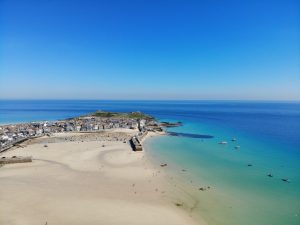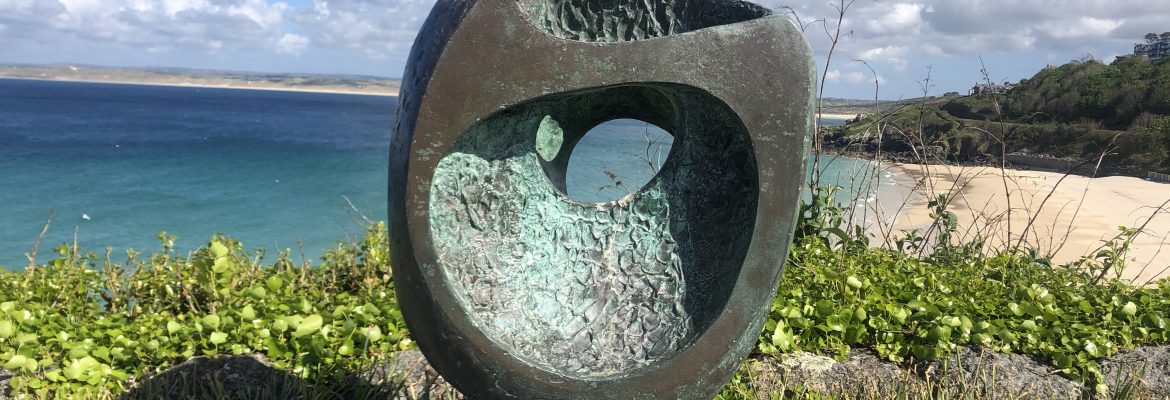
Barbara Hepworth
When you think of St Ives, what do you think of?
Is it the distinct mix of old and new, that’s hidden in the maze of cobbled streets. Perhaps it’s the rugged coastline against its white sandy beaches, that lead seamlessly to the ocean. For many, it is all of these things and more, so it’s no surprise that creatives flock here from all over, to experience the stunning aesthetics of the area and its unique clarity of light.
St Ives is home to an abundance of art galleries, exhibition spaces and world renowned collections. Which is why it is now recognised as the artistic hub of the south west. So whether you’re looking for something specific or you just want to improve your artistic knowledge, St Ives is certainly sure to teach you a thing or two.
So where do we begin…
St Ives is the inspiration and setting, for the rise of one of the greatest sculptors of the 20th century, Barbara Hepworth.
Barbara Hepworth
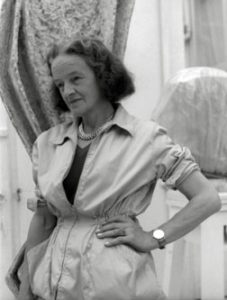 Barbara Hepworth, born in 1903, was an extremely profound woman, who quickly became famous for her distinct work in sculpting. Growing up in Yorkshire, she possessed an affinity to nature and took inspiration from her surroundings.
Barbara Hepworth, born in 1903, was an extremely profound woman, who quickly became famous for her distinct work in sculpting. Growing up in Yorkshire, she possessed an affinity to nature and took inspiration from her surroundings.
“Inspiration always comes from either the artist in the landscape, or the spectator of the figure observing the landscape. These qualities are of profound importance to the sculpture”.
After studying in both Leeds and at the Royal College of Art in London, Hepworth was awarded the West Riding Scholarship which gave her the freedom to travel. She subsequently became wife to John Skeaping after they shared a brief love affair in Rome. Hepworth discovered a huge amount while living in the Mediterranean, including her skill for carving marble, which was taught to her by the master carver Giovanni Ardini. She described her joy of carving as…
“A rhythm of movement, like dancing and skating”.
St Ives
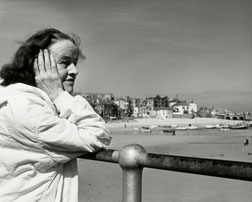 By the time Hepworth came to live on Cornish shores, she was a mother of four and living with her second husband, artist Ben Nicholson. For her first few years in Cornwall, Hepworth fought for the time and space to pursue her love for sculpting, but it was the post war years that saw Hepworth really come into her own and returned to her passion.
By the time Hepworth came to live on Cornish shores, she was a mother of four and living with her second husband, artist Ben Nicholson. For her first few years in Cornwall, Hepworth fought for the time and space to pursue her love for sculpting, but it was the post war years that saw Hepworth really come into her own and returned to her passion.
Initially she worked with materials that were easy to access and played with what she had to hand. She had such a unique talent of narrating harmony with whatever she could find and sought her inspiration from the richness of natural materials, such as wood and stone. Experimenting with small sculptures, she cut shapes and added strings, to articulate what she called ‘the negative space’, as if to disclose their inner structural natures.
Trewyn Studios
Always innovating and looking for opportunity, Hepworth purchased an old dance studio in St Ives, ’Palet de Dance’, now the ‘Trewyn Studios’.
“Finding Trewyn Studio was a sort of magic, here was a studio, a yard and garden where I could work in open air and space”.
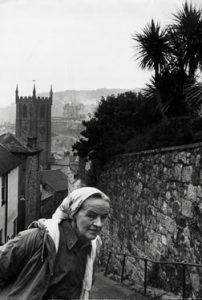
Hepworth was fascinated by landscape and St Ives in particular, was uniquely inspirational to her. She had an attraction to natural forms, with many of her most famous pieces, taking inspiration from the coastal contours, during her walks from St Ives.
“Here in St Ives, I appreciate every moment of the brilliance and clarity of the space within the forms and through the forms”.
By the 1950’s Hepworth was known as an international artist and it was at this time she was introduced to working with bronze, which is the material she later became best known for.
Did you know?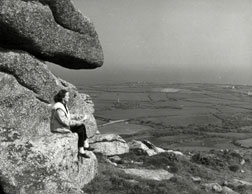
The landscape around St Ives, has the highest concentration of ancient stone and bronzed age sites, in western Europe.
The ‘Lanyon Quoit’, ‘Men-an-Tol’ and ‘Merry Maidens’, can all be enjoyed, just a short distance from St Ives.
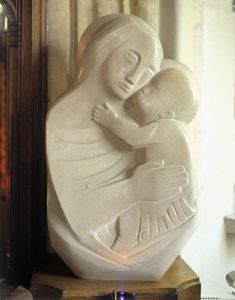
Hepworth was very much a family person and in 1953 she carved the famous ‘Madonna and Child (Bianco del Mare)’, in touching memory of her son Paul, who died in a plane crash whilst serving with the RAF.
This iconic piece, can be found in the St Ives Parish Church.
Later life of Barbara Hepworth
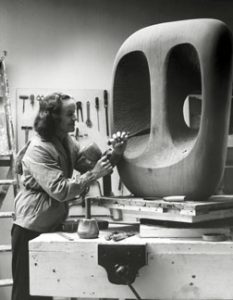
Hepworth was recognised for her work in 1965 when she became Dame Barbara Hepworth.
Later she divorced her husband and with her children all grown up, she now had more time to focus on her art. Fortunately her public commissions were now able to provide her more financial freedom, to work on larger scales.
“While always remaining constant to my condition about truth to material, I found a greater freedom for myself”.
Her work was undeniably at the forefront of European modernism and she revolutionised the possibilities of carving, by envisioning and forming interiors to her work. As she quickly moved from figuration and representation, to abstraction. She portrayed how idealism and political engagement were challenged at the time, but also by the demands of her own personal life.
Hepworth had an untimely and tragic death, aged 73, in a house fire.
The Barbara Hepworth Museum & Sculpture Garden
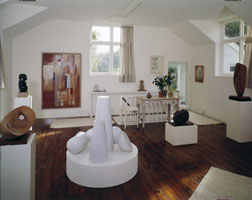
We feel lucky to have an affinity with Barbara Hepworth from her work and life, here in St Ives.
The Barabara Hepworth Museum and Sculpture Garden is an unexpected oasis in the middle of St Ives. Opened in her memory, this museum contains the largest collection of her work today.
Here’s how you can reach the Barbara Hepworth Museum from Trevose Harbour House…
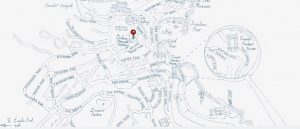
Barbara Hepworth Museum, Barnoon Hill, St Ives, Cornwall, UK TR26 1AD
The Tate
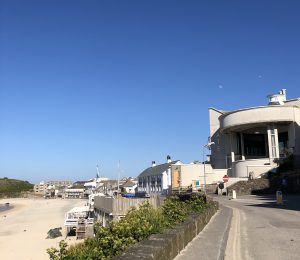
The Tate, is one of the best of its discipline. Home to a host of exhibitions and stage to the creative work of many modern, British artists. It celebrates the rich history of the St Ives area through creative experimentation.
There’s not many places you will discover the story of modern art, while taking in expansive views across the Atlantic Ocean. You can then finish off the day with a relaxing sunset on Porthmeor Beach; there really isn’t a better setting for showcasing such iconic design.
Here’s how you can reach The Tate from Trevose Harbour House…
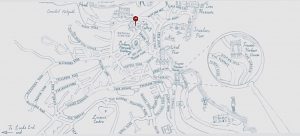
Sheila Oliner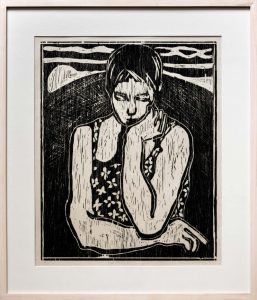
This week we learnt of the sad passing of local artist, Sheila Oliner, age 89. Much like Barbara Hepworth, Sheila Oliner was influenced by the Cornish landscape and revolved her work around women’s lives, observing both her own and her children’s experiences. Sheila helped to raise substantial funds for The Tate, as well as for the local community. Our thoughts are with her family and friends.
Sheila Oliner – Full Moon (wood cutting)
Sustainability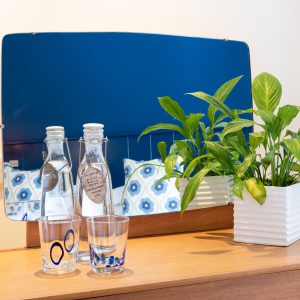
Once it is safe for us to re-open our doors, we will be offering incentive tickets to the The Tate Museum. So if you’re lucky enough to be staying with us at either Trevose Harbour House or St Ives Studios make sure to travel to us by train, to help save our planet. This initiative is part of our sustainable efforts at Trevose Harbour House and not only that, the train journey to St Ives along the South Coast, is definitely something to experience!
We’d love you to share your favourite memories of St Ives with us.
Simply tag @trevoseharbourhouse or @stivesstudios in your Instagram posts and we will share these treasured moments on our story!
Don’t forget our Lockdown Competition Giveaway!
Check out our latest Instagram post @trevoseharbourhouse for details on how to enter …
From our small team at Trevose Harbour House, we hope you, your family and friends are well.

